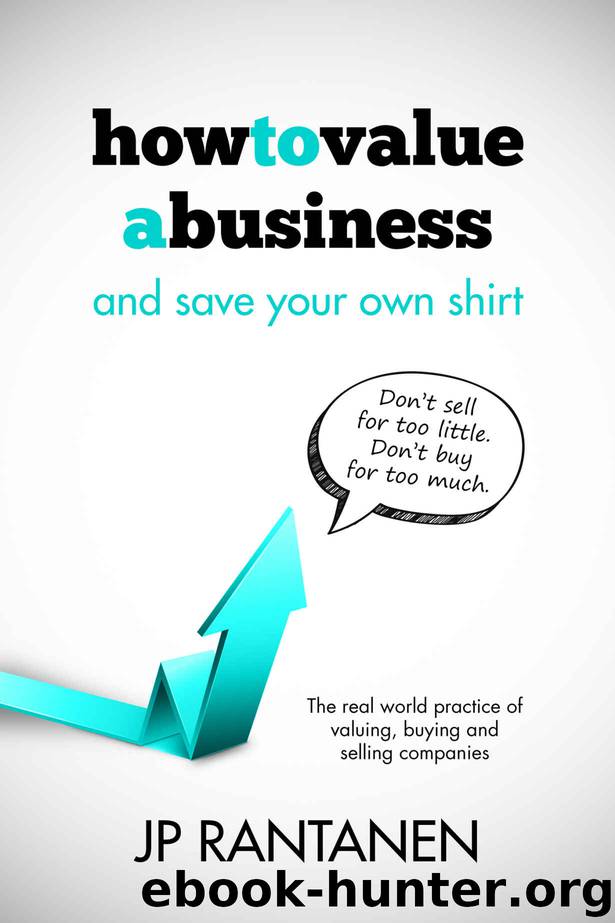How to Value a Business and Save Your Own Shirt: The real world practice of valuing, buying and selling companies by JP Rantanen

Author:JP Rantanen [Rantanen, JP]
Language: eng
Format: azw3
ISBN: 9789529360314
Publisher: JP Rantanen
Published: 2015-10-15T04:00:00+00:00
5.2 Net worth
Net worth (the value of the debt-free assets of a company, i.e., assets minus debts) is often used as a reference method in combination with yield value. We use two different valuation methods in order to get a valuation good enough for determining the selling price and arranging funding. At its simplest, net worth is obtained by deducting the company’s debts from its assets, thereby getting its worth.
However, the starting point is the balance sheet that follows its specific tax calculation logic. The service value of assets (such as machinery that wears out) or their current value may be significantly higher or lower than their value in the balance sheet. You must study the company carefully and use expertise to know which is the case. Net worth is particularly important for the funding of a business transfer. Depending on the line of business, a careful study of the assets shows us the guarantees available and the debts of the company that will remain with the business.
A company with few assets and large profits is, as a company, certainly better than a company in the same sector that has a great deal of assets but produces only a little profit. We must distinguish between the value of the business operations and the value of the assets the company manages, also keeping them separate from the value of the owner’s possessions. The value of the business operations is based only on the assets that are available for running the business and making profits.
By excess assets we mean assets that have a value but not from the point of view of the buyer in actually running the business. Usually such assets include cars, too fancy and too many; valuable works of art on the walls; perhaps a yacht lying unused in a harbour; property investments; memberships in golf clubs; share portfolios; a second or holiday home; and extra cash. What is not included in excess assets is probably the true assets needed to run the business.
Any production factor that does not contribute to profits, even in the long run, is unnecessary from the point of view of operating the business. We can go even further. Any production factor that does not have an effect on the buyer’s profit-making capability after the purchase deal is completed is valueless from the point of view of valuation. How can we explain then that, in many companies, the owner’s car is disproportionately expensive in relation to its yield value? Moving about is just as easy in a cheaper car.
If, for example, half of the value of the owner’s car were invested in the company’s production equipment or in staff training, the company profits would be quite different, or maybe not. The car may be the key source of motivation for the owner so the joy it gives helps him through the long days year after year. The car may be a dream come true or the reason why risks have been taken. The joy of owning it creates the euphoria that leads to high profits.
Download
This site does not store any files on its server. We only index and link to content provided by other sites. Please contact the content providers to delete copyright contents if any and email us, we'll remove relevant links or contents immediately.
The Black Swan by Nassim Nicholas Taleb(6984)
Bad Blood by John Carreyrou(6516)
Pioneering Portfolio Management by David F. Swensen(6206)
Millionaire: The Philanderer, Gambler, and Duelist Who Invented Modern Finance by Janet Gleeson(4349)
Skin in the Game by Nassim Nicholas Taleb(4141)
Bullshit Jobs by David Graeber(4056)
The Money Culture by Michael Lewis(4049)
Skin in the Game: Hidden Asymmetries in Daily Life by Nassim Nicholas Taleb(3903)
The Wisdom of Finance by Mihir Desai(3625)
Blockchain Basics by Daniel Drescher(3470)
Liar's Poker by Michael Lewis(3350)
Fooled by Randomness: The Hidden Role of Chance in Life and in the Markets by Nassim Nicholas Taleb(3018)
Hands-On Machine Learning for Algorithmic Trading by Stefan Jansen(3005)
The Intelligent Investor by Benjamin Graham Jason Zweig(2982)
Mastering Bitcoin: Programming the Open Blockchain by Andreas M. Antonopoulos(2964)
Investing For Dummies by Eric Tyson(2876)
The Power of Broke by Daymond John(2874)
Market Wizards by Jack D. Schwager(2628)
Zero Hour by Harry S. Dent Jr. & Andrew Pancholi(2595)
